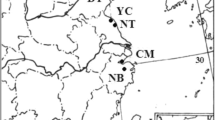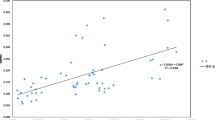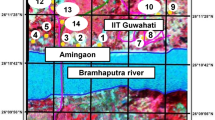Abstract
Limonium sinense is a halobiotic herb endemic to China that has been traditionally used for hundreds of years for its good restorative function. Genetic variation and population structure of this species were investigated by using amplified fragment length polymorphisms (AFLPs) and inter simple sequence repeats (ISSRs). A high level of genetic diversity was detected [AFLP: H E = 0.284, percentage of polymorphic loci (PPL) = 92.68 %; ISSR: H E = 0.257, PPL = 85.71 %] at the species level with POPGENE. Based on analysis of molecular variation (AMOVA), the among-population component accounted for 29.03 % (AFLP) and 28.81 % (ISSR) of the genetic variation, indicating that most of the genetic variation was between individuals within populations. The Shannon diversity index (I) was higher for AFLP (0.432) than for ISSR (0.395). Five main clusters were shown in the unweighted pair-group method with arithmetic mean (UPGMA) dendrogram created using TFPGA, consistent with the result of principal coordinate analysis using NTSYS. In situ conservation is advocated first. Keeping a stable environment for this halobiotic herb is necessary. For ex situ conservation, it is important to establish a germplasm bank. AFLP and ISSR markers were proved to be efficient tools in assessing the genetic variation among populations of L. sinense. The patterns of variation appeared to be consistent for these two marker systems, and they can be used for management of genetic structure, protection of the halobiotic plant, and conservation of germplasm.




Similar content being viewed by others
References
Baker HG (1966) The evolution, functioning, and breakdown of heteromorphic incompatibility systems I. The Plumbaginaceae. Evolution 20:349–368
Chant SR (1993) Plumbaginaceae. In: Heywood VH (ed) Flowering plants of the world, 2nd edn. Batsford, London, pp 78–79
Chaung SS, Lin CC, Lin J, Yu KH, Hsu YF, Yen MH (2003) The hepatoprotective effects of Limonium sinense against carbon tetrachloride and beta-D-galactosamine intoxication in rats. Phytother Res 17:784–791
Crespo MB, Laguna E (1993) Nuevas localidades de Limonium dufourii (Girard) O. Kuntze (Plumbaginaceae). Anales Del Jardín Botánico de Madrid 51:154–155
Dong BH (2005) Research on the conservation of Limonium sinense in the coast of Jiangsu. Chinese Wild Plant Res 24:28–30
Eduardo LB, Joaa OS, George JS (2001) Self-incompatibility, inbreeding depression and crossing potential in five Brazilian Pleurothallis (Orchidaceae) Species. Ann Bot 88:89–99
Erben M (1979) Karyotype differentiation and its consequences in Mediterranean Limonium. Webbia 34:409–417
Excoffier L, Smouse PE, Quattro JM (1992) Analysis of molecular variance inferred from metric distances among DNA haplotypes: application to human mitochondrial DNA restriction data. Genetics 131:479–491
Falk DA, Holsinger KE (1991) Genetics and conservation of rare plants. Oxford University Press, New York
Francisco-Ortega J, Santos-Guerra A, Kim SC, Crawford DJ (2000) Plant genetic diversity in the Canary Islands: a conservation perspective. Am J Bot 87:909–919
Gaiero P, Mazzella C, Agostini G, Bertolazzi S, Rossato M (2011) Genetic diversity among endangered Uruguayan populations of Butia Becc. species based on ISSR. Plant Syst Evol 292:105–116
Ge XJ, Zhang LB, Yuan YM, Hao G, Chiang TY (2005) Strong genetic differentiation of the East-Himalayan Megacodon stylophorus (Gentianaceae) detected by inter-simple sequence repeats (ISSR). Bio Conserv 14:849–861
Hamrick JL (1982) Plant population genetics and evolution. Am J Bot 69:1685–1693
Hamrick JL, Godt MJW (1990) Allozyme diversity in plant species. In: Brown AHD, Clegg MT, Kahler AL, Weir BS (eds) Plant population genetics, breeding, and genetic resources. Sinauer, Sunderland, pp 43–63
Hamrick JL, Godt MJW (1995) Conservation genetic of endemic species. In: Avise JC, Hamrick JL (eds) Conservation genetics. Chapman & Hall, New York, pp 281–304
Hamrick JL, Godt MJW (1996) Effects of life history traits on genetic diversity in plant species. Philos Trans R Soc London Biol Sci 351:1291–1298
Hamrick JL, Godt MJW, Murawski DA, Loveless MD (1991) Correlations between species traits and allozyme diversity: implications for conservation biology. In: Falk DA, Holsinger KE (eds) Genetics and conservation of rare plants. Oxford University Press, New York, pp 75–86
Jian SG, Zhong Y, Liu N, Gao ZZ, Wei Q, Xie ZH, Ren H (2006) Genetic variation in the endangered endemic species Cycas fairylakea (Cycadaceae) in China and implications for conservation. Biol Conserv 15:1681–1694
Juan A, Crespo MB, Cowan RS, Lexer C, Fay MF (2004) Patterns of variability and gene flow in Medicago citrina, an endangered endemic of islands in the western Mediterranean, as revealed by amplified fragment length polymorphism (AFLP). Mol Ecol 13:2679–2690
Lewontin RC (1972) The apportionment of human diversity. Evol Biol 6:381–398
Li HL (1978) Plumbaginaceae, Flora of Taiwan, vol IV. Editorial Committee of the Flora of Taiwan, Taipei, pp 90–93 (Edited, Published)
Li A, Ge S (2006) Genetic variation and conservation of Changnienia amoena, an endangered orchid endemic to China. Plant Syst Evol 258:251–260
Li XX, Ding XY, Chu BH, Zhou Q, Ding G, Gu S (2008) Genetic diversity analysis and conservation of the endangered Chinese endemic herb Dendrobium officinale Kimura et Migo (Orchidaceae) based on AFLP. Genetica 133:159–166
Lin LC, Chou CJ (2000) Flavonoids and phenolics from Limonium sinense. Planta Med 66:382–383
Maguire TL, Peakall R, Saenger P (2002) Comparative analysis of genetic diversity in the mangrove species Avicennia marina (Forsk.) Vierh. (Avicenniaceae) detected by AFLPs and SSRs. Theor Appl Genet 104:388–398
Maunder M, Culham A, Alden B, Zizka G, Orliac C, Lobin W, Bordeu A, Ramirez JM, Glissmann-Gough S (2000) Conservation of the Toromiro tree: case study in the management of a plant extinct in the wild. Conserv Biol 14:1341–1350
Miller MP (1997) Tools for population genetic analysis (TFPGA) 1.3: a windows program for the analysis of allozyme and molecular population genetic data. Department of Biological Sciences, Northern Arizona University, Arizona, USA
Miller MP (1998) AMOVA-PREP. A program for the preparation of AMOVA input files from dominant-marker raw data, release 1.01. Department of Biological Sciences, Northern Arizona University, Arizona, USA
Mueller UG, Wolfenbarger LL (1999) AFLP genotyping and fingerprinting. Trends Ecol Evol 14:389–394
Nei M (1972) Genetic distances between populations. Am Nat 106:283–292
Nei M (1973) Analysis of gene diversity in subdivided populations. Proc Natl Acad Sci 70:3321–3323
Nybom H (2004) Comparison of different nuclear DNA markers for estimating intraspecific genetic diversity in plants. Mol Ecol 13:1143–1155
Palacios C, González-Candelas F (1997) Analysis of population genetic structure and variability using RAPD markers in the endemic and endangered Limonium dufourii (Plumbaginaceae). Mol Ecol 6:1107–1121
Palacios C, Kresovich S, González-Candelas F (1999) A population genetic study of the endangered palnt species Limonium dufourii (Plumbaginaceae) based on amplified fragment length polymorphism (AFLP). Mol Ecol 8:645–657
Palop-Esteban M, Segarra-Moragues JG, González-Candelas F (2007) Historical and biological determinants of genetic diversity in the highly endemic triploid sea lavender Limonium dufourii (Plumbaginaceae). Mol Ecol 16:3814–3827
Palop-Esteban M, Segarra-Moragues JG, González-Candelas F (2011) Polyploid origin, genetic diversity and population structure in the tetraploid sea lavender Limonium narbonense Miller (Plumbaginaceae) from eastern Spain. Genetica 139:1309–1322
Poulin J, Weller SG, Sakai AK (2005) Genetic diversity does not affect the invasiveness of fountain grass (Pennisetum setaceum) in Arizona, California and Hawaii. Diver Distrib 11:241–247
Rodríguez S, Palop ML, Palacios C, González-Candelas F (2003) Molecular and morphological differentiation in Limonium dufourii (Plumbaginaceae), an endangered Mediterranean plant. Conserv Genet 4:383–391
Rohlf FJ (2000) NTSYS-pc : numerical taxonomy and multivariate analysis system, Version 2.1., New York, USA
Schaal BA, Hayworth DA, Olsen KM, Rauscher JT, Smith WA (1998) Phylogeographic studies in plants: problems and prospects. Mol Ecol 7:465–474
Shah A, Li DZ, Gao LM, Li HT, Moller M (2008) Genetic diversity within and among populations of the endangered species Taxus fuana (Taxaceae) from Pakistan and implications for its conservation. Biochem System Ecol 36:183–193
Suárez-García C, de Paz Pérez, Julia Febles R, Caujapé-Castells J (2009) Genetic diversity and floral dimorphism in Limonium dendroides (Plumbaginaceae), a woody Canarian species on the way of extinction. Plant Syst Evol 280:105–117
Tang XH, Jing G, Jin C, Xu LZ, Tang YH, Dou H, Yu W, Zhao XN (2007) Expression of VDAC regulated by extracts of Limonium sinense Ktze root against CCl4-induced liver damage. Int J Mol Sci 8:204–213
Thul ST, Srivastava AK, Singh SC, Shanker K (2011) Genetic and chemical diversity of high mucilaginous plants of Sida complex by ISSR markers and chemical fingerprinting. Mol Biotechnol 49(1):77–81
Tian FP, Shi YJ, Chen ZX (2010) The distribution and research of wild plant resources of Limonium Mill. in China. CaoYe Yu Xu Mu 172:49–52
Vos P, Hogers R, Bleeker M, Reijans M, Lee TVD, Hornes M, Frijters A, Pot J, Peieman J, Kuiper M, Zabeau M (1995) AFLP: a new technique for DNA fingerprinting. Nucleic Acids Res 23:4407–4414
Vrijenhoek RC (1987) Population genetics and conservation. In: Western D, Pearl MC (eds) Conservation for the 21st century. Oxford University Press, New York, pp 89–98
Wang L, Liu Y, Hua LY, Zhang LL (2010) Studies on the resources characteristic and chemical components for wild Limonium aureum (L.) Hill. Northern Horticulture 11:217–218
Wong KC, Sun M (1999) Reproductive biology and conservation genetics of Goodyera procera (Orchidaceae). Am J Bot 86:1406–1413
Wright S (1951) The genetical structure of populations. Ann Eugenetics 15:323–354
Wu HF, Li ZZ, Huang HW (2006) Genetic differentiation among natural populations of Gastrodia elata (Orchidaceae) in Hubei and germplasm assessment of the cultivated populations. Biodivers Sci 14:315–326
Yeh FC, Yang RC, Boyle T (1999) POPGENE. Microsoft windowsbased freeware for population genetic analysis. Release 1.31. University of Alberta, Edmonton
Zawko G, Krauss SL, Dixon KW, Sivasithamparam K (2001) Conservation genetics of the rare and endangered Leucopogon obtectus (Ericaceae). Mol Ecol 10:2389–2396
Zhang ZY, Chen YY, Li DZ (2005) Detection of low genetic variation in a critically endangered Chinese pine, Pinus squamata, using RAPD and ISSR markers. Biochem Genet 43:239–249
Zhou XZ, Li JT, Cui GJ (1998) The bionomics of Limonium bicolor and its mass propagation. Hebei J Forestry Orchard Res 13:331–334
Acknowledgments
The authors thank the National Natural Science Foundation of China (no. 31000142), Natural Science Foundation of Jiangsu Province (no. BK2011421), Foundation of Yancheng Institute of Technology (XKR2010003), and Agricultural Science and Technology Project (YKN2011003) for financial support.
Author information
Authors and Affiliations
Corresponding author
Rights and permissions
About this article
Cite this article
Ding, G., Zhang, D., Yu, Y. et al. Population genetic diversity and divergence of the halobiotic herb Limonium sinense estimated by AFLP and ISSR, and implications for conservation. Plant Syst Evol 299, 131–138 (2013). https://doi.org/10.1007/s00606-012-0710-9
Received:
Accepted:
Published:
Issue Date:
DOI: https://doi.org/10.1007/s00606-012-0710-9




